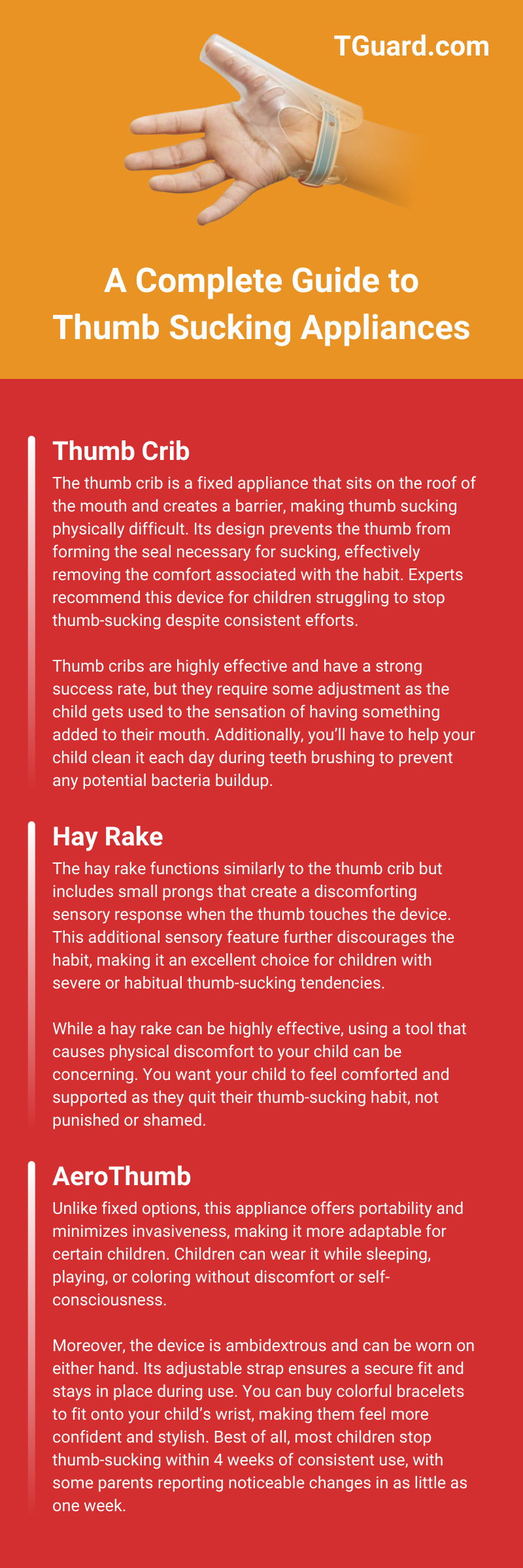Many of us have seen babies or toddlers sucking their thumbs as they lay in their cribs or play with toys. Thumb and finger sucking is perfectly natural for kids that are four years old and younger since it provides a sense of security and comfort. Their adult teeth haven’t come in yet at this age, so there’s usually little concern for jaw and palate development issues.
However, by five years old, consistent thumb sucking can create issues for oral development if left unaddressed. Some parents use different fixed or removable devices to help their child break the habit. This complete guide details what thumb-sucking appliances are, the common options, and tips for ending thumb-sucking.
What Are Thumb Sucking Appliances?
Thumb-sucking appliances are devices specifically designed to help stop persistent thumb-sucking habits. Most of these devices go inside your child’s mouth behind the bottom set of teeth and below the tongue; other thumb-sucking appliances go on the upper jaw.
These appliances also work on a psychological level by consistently reminding the child to avoid placing their thumbs in their mouth. Before introducing a thumb-sucking appliance, consulting a pediatric dentist or orthodontist is crucial. They can provide a thorough evaluation to determine the right solution tailored to the child’s specific needs.
What Age Should You Use Them
Since thumb sucking is normal for toddlers and babies, you don’t want to force your child to quit when they’re too young. You should start monitoring the habit when they are four years old. If your child continues to suck their thumb by the time they’re five years old, you should talk to their dentist about the next steps.
Parent Tip
Early intervention reduces the risk of long-term damage to your child’s jaw and teeth while promoting healthy oral habits.
How Long Kids Usually Wear Them
The typical duration for wearing thumb-sucking appliances ranges from three to six months. This timeframe allows sufficient consistency to break the habit while also permitting gradual realignment of oral structures that may have been affected. If you use a removable device, put it on your child regularly, following the dentist’s directions to ensure it works properly. You should only draw out the process if you fail to use a device as often as possible.
Common Types of Thumb Sucking Appliances
Your child’s dentist can help guide you on the best thumb-sucking device based on your child’s needs. Some common types of thumb-sucking appliances include:
Thumb Crib
The thumb crib is a fixed appliance that sits on the roof of the mouth and creates a barrier, making thumb sucking physically difficult. Its design prevents the thumb from forming the seal necessary for sucking, effectively removing the comfort associated with the habit. Experts recommend this device for children struggling to stop thumb-sucking despite consistent efforts.
Thumb cribs are highly effective and have a strong success rate, but they require some adjustment as the child gets used to the sensation of having something added to their mouth. Additionally, you’ll have to help your child clean it each day during teeth brushing to prevent any potential bacteria buildup.
Hay Rake
The hay rake functions similarly to the thumb crib but includes small prongs that create a discomforting sensory response when the thumb touches the device. This additional sensory feature further discourages the habit, making it an excellent choice for children with severe or habitual thumb-sucking tendencies.
While a hay rake can be highly effective, using a tool that causes physical discomfort to your child can be concerning. You want your child to feel comforted and supported as they quit their thumb-sucking habit, not punished or shamed.
AeroThumb
Our complete guide to thumb-sucking appliances would be incomplete without mentioning the AeroThumb. This non-fixed appliance uses medical-grade, BPA-free plastics and prioritizes comfort. Your child wears the “glove” directly on the thumb, crafted from soft, flexible materials.
Unlike fixed options, this appliance offers portability and minimizes invasiveness, making it more adaptable for certain children. Children can wear it while sleeping, playing, or coloring without discomfort or self-consciousness.
Moreover, the device is ambidextrous and can be worn on either hand. Its adjustable strap ensures a secure fit and stays in place during use. You can buy colorful bracelets to fit onto your child’s wrist, making them feel more confident and stylish. Best of all, most children stop thumb-sucking within 4 weeks of consistent use, with some parents reporting noticeable changes in as little as one week.
What To Avoid Using
When addressing thumb-sucking habits, avoid methods that may be harmful or counterproductive. Choosing the wrong interventions can delay progress, cause distress, or lead to secondary issues such as anxiety or behavioral resistance. Only use methods that prioritize the child’s well-being and constructively encourage habit-breaking.
Don’t Opt for Pacifiers
Offering your child a pacifier in place of sucking their thumb may initially seem like a great idea since it keeps their hands out of their mouth. While this can be more sanitary and reduces the skin irritation often caused by thumb sucking, it does nothing to help the potential dental problems.
A pacifier impacts the jaw and teeth in the same way as thumb sucking, so it could still cause dental problems during childhood. Additionally, weaning your child off of a pacifier can be as hard as getting them to stop thumb sucking, especially if the pacifier replaces thumb sucking.
Don’t Use Punishments
Punishment-based approaches can create unnecessary stress and lead to negative emotional associations, which are more likely to worsen the problem than solve it. Punishment also risks damaging the trust and communication between the parent and child.
Don’t use thumb-sucking appliances that your child expresses are uncomfortable, as this may cause more harm than good. Instead, reward and reinforce positive behaviors with praise and encouragement.
Correct with Compassion
The best way to help your child quit thumb-sucking is to be compassionate and work with them. Sit down with them to explain the issue with their thumb-sucking habit and help them understand why they should stop.
Removable appliances, such as a thumb-sucking glove, often work best because they help children end the habit without placing an uncomfortable dental device in their mouth. Plus, thumb-sucking gloves have small slits along the side that prevent the suction sensation, which eliminates the enjoyment of the habit.
Every child is different, so finding the right approach might take patience, experimentation, and creativity. Always prioritize choosing methods that feel comfortable and supportive for your child. If you’re unsure about the best tools or techniques, consulting a dentist or orthodontist can put you on the right track. With time, your child will develop healthier habits that promote oral health and self-care.


